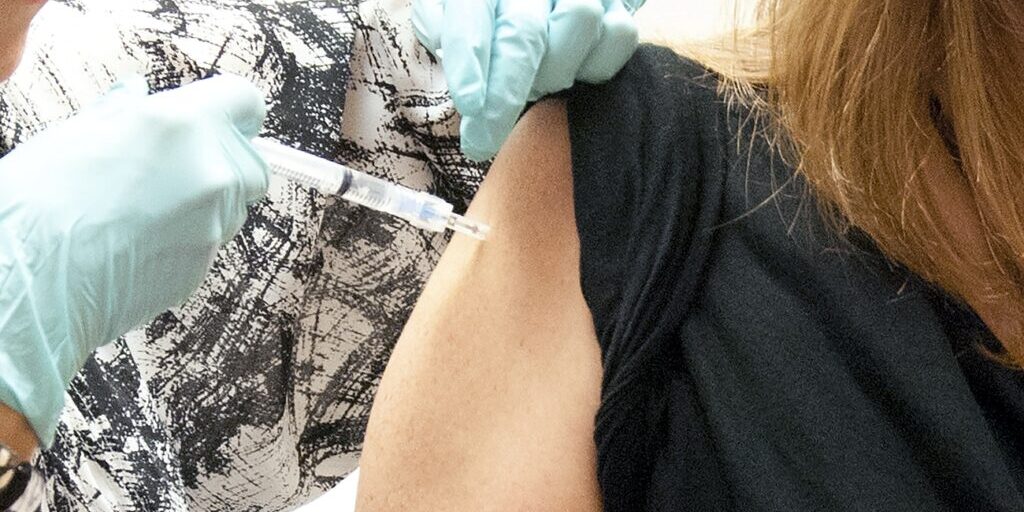Nome’s tribal health care provider expects to be receiving the first rounds of a COVID-19 vaccine as early as next week. KNOM reports on how Norton Sound Health Corporation (NSHC) plans to distribute those initial doses.
NSHC plans to follow federal and state guidelines for a vaccine roll-out by targeting their nursing home residents and staff at the Quyanna Care Center when the first doses arrive. That’s according to NSHC Medical Director Mark Peterson.
“And then we’ll just turn that around and start vaccinating our frontline healthcare workers. And everybody from doctors, nurses, housekeeping staff, laundry staff, everybody that’s involved with frontline COVID-19 direct contact work.”
– Dr. Mark Peterson
But there are some potential logistical challenges in distribution. The state of Alaska is expecting around 35,000 doses of a vaccine from drug company Pfizer as early as next week. That’s pending an emergency authorization from the Food and Drug Administration.
Pfizer’s vaccine has to be kept frozen at a temperature of minus 95 degrees Fahrenheit and once thawed, lasts in refrigeration for five days.
But Peterson feels pretty confident that if the vaccine is “thawed out”, so to speak, in Anchorage, the five days of refrigeration will be plenty long enough to at least get to Nome. It’ll be more challenging to reach village health clinic workers who are also considered part of the frontline workers prioritized for the first phase of the vaccine.
Those vaccines are too sensitive to put on a bush plane. “It also cannot withstand intense vibration,” Peterson said of the vaccine.
NSHC is working to get some of their clinic first responders vaccinated in Nome.
But Peterson is hopeful for the approval of another vaccine, one made by the drug company Moderna. That could also be approved and on the way within weeks. The Moderna vaccine can be stored in a refrigerator for up to a month, providing much greater flexibility.
“That one is not as sensitive to shaking and vibration. The Modernas can be really helpful to our region, especially for the regional villages. We’ll be able to just stick that on a plane and send it right out to the villages.”
– Dr. Mark Peterson
Transportation isn’t the biggest challenge that local health officials anticipate. They’re worried about convincing people to take it.
Megan Mackiernan is the Director of Quality Improvement, Risk Management, and Privacy Officer for NSHC. She is working on the corporation’s vaccination efforts. She explained that the dose does not inject any form of the virus that causes COVID-19, dead or alive.
“All vaccines work by teaching your immune system, what bad things look like. And so that when the when they’re presented later that your body knows to fight them off. This is kind of like wanted posters. We post wanted posters, so that if you see the bad guy, you know, to stay away from them.”
– Megan Mackiernan
The COVID-19 vaccine uses mRNA, or messenger RNA. The RNA acts as a set of instructions for the body to make the protein that’s on the outside, or the crown, of the coronavirus. That’s recognizable by a bunch of little spikes.
“And your body takes those instructions that makes the protein and then recognizes, hey, that’s not supposed to be here. Then your body will attack it, kill it, and remember hey this protein is not supposed to be there. So then if COVID ever enters your body, your body says, I already know that’s not supposed to be here, and it can attack it faster.”
-Megan McKiernan
While mRNA vaccines haven’t been used in the United States, Mackiernan says mRNA technology and research has been used during the development of other vaccines. The CDC reports that “Early stage clinical trials using mRNA vaccines have been carried out for influenza, Zika, rabies, and cytomegalovirus (CMV)”.
There have been some side effects like aches, chills and a small fever. The most common, Mackiernan says, is soreness in the arm at the injection site. Younger and healthier people tend to have a stronger reaction since the body is able to fight harder. But the side effects are far easier to deal with then the potentially deadly COVID-19, said Mackiernan.
“In fact, the vaccines that use the technology are 90 to 95% effective at preventing symptomatic COVID-19. And studies proved to be 100% effective at preventing death from COVID-19.”
Dr. Peterson said the goal for NSHC is to vaccinate over 60-70% of the Norton Sound region. The health consortium doesn’t have exact numbers or dates yet, but Peterson expects NSHC to get their first allotment of about 300 doses of the Pfizer vaccine around December 16th.
Correction: A previous version of this story stated “While mRNA vaccines haven’t been used in the United States, the Ebola virus vaccine uses the technology, as do those for diseases caused by other coronaviruses like SARS.” This has been amended to report that mRNA technology has been used in research and development for vaccines for those illnesses.
Image at Top: A woman receiving a dose of the investigational NIAID/Glaxo Smith Kline (GSK) Ebola vaccine. Public Health Image Library; Centers for Disease Control and Prevention. CC0 1.0




